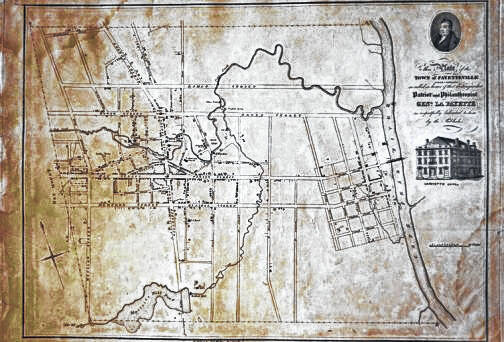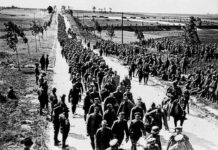
An 1825 map of Fayetteville provides perspective of the growth of the metro area over the past almost 200 years.
THIS WEEK IN HISTORY
Robeson County History
100 Years Ago: Pembroke Police chief shot and seriously wounded: A story in the May 28, 1923 Robesonian reported that Hubbard Lowery, chief of police of Pembroke and for 20 years a deputy sheriff of Robeson County was seriously wounded today about noon when he was shot by a boy by the name Locklear at the home of Duckery Brooks. The shooting took place about 3 miles west of Pembroke, while Lowery was on a mission of collecting taxes.
50 Years Ago: The May 27, 1973 Robesonian reported the following: Baccalaureate service at Lumberton High School will be held tonight at 8 p.m. in advance of graduation exercises which will be Friday at 8 p.m. The order of service for the baccalaureate will include “Area in F Major” with Nancy C Fountain, organist; the invocation by the Rev. Robert F. Sloop; “Amazing Grace: with solo by Dehaeva Marie Drake.
Five Years Ago: On May 27, 2018, the Robesonian reported the following: Senator: Pay hike is a ‘big deal’ for Robeson County. A Republican budget proposal to give state workers a starting salary of $15 an hour is “a pretty big deal for many people in Robeson and Columbus counties,” said Sen. Danny Britt, a Republican who represents both counties. Budget writers within the GOP announced Thursday a proposal to pay all full-time state employees at least $31,200 annually. That would include public school custodians and cafeteria workers, The University of North Carolina at Pembroke’s housekeepers, groundskeepers and administrative assistants, and workers in other agencies, such as the departments of Transportation and Corrections.
One Year Ago: On May 28, 2022, the Robesonian reported the following: Sheriff to ask for more school resource officers following Texas school shooting. LUMBERTON — “No parent should have to worry about a cowardly shooter entering a school to commit mass murder.” Those were the words shared on social media Tuesday by Robeson County Sheriff Burnis Wilkins as he reacted to the shooting at Robb Elementary School that left 21 people including 19 children dead in Uvalde, Texas.
North Carolina History
On May 29, 1831, much of Fayetteville burned to the ground.
Starting in a kitchen on the northwest corner of Market Square, the fire’s central starting point was part of the reason it caused so much destruction. Though townspeople began trying to extinguish it around it noon, the fire continued to spread rapidly, destroying many of the nearby structures, including the building where the state had ratified the U.S. Constitution.
The town’s fire engine was unable to contain the blaze and, indeed, was destroyed itself in the flames. All destroyed, and the streets became a chaotic mess of people trying to save family members and possessions as the fire roared through town.
After four hours the inferno was quenched but not before taking more than 600 buildings including hundreds of homes, a school, two hotels, 105 stores, two banks and all but one of the city’s churches.
Although many people were injured and almost everyone displaced, no one was killed. Private donations poured into town once news of the disaster spread, with over $100,000 collected and distributed to the people of Fayetteville.
Many of today’s older buildings in the city, such as the Market House, are ones built after this spectacular fire.
Nation and World History
On May 27, 1935, the U.S. Supreme Court, in Schechter Poultry Corp. v. United States, unanimously struck down the National Industrial Recovery Act, a key component of President Franklin D. Roosevelt’s “New Deal” legislative program.
On May 28, 1863, the 54th Massachusetts Volunteer Infantry Regiment, made up of freed Blacks, left Boston to fight for the Union in the Civil War.
On May 29, 1988, President Ronald Reagan and Soviet leader Mikhail S. Gorbachev opened their historic summit in Moscow.
On May 30, 1989, student protesters in Beijing erected a “Goddess of Democracy” statue in Tiananmen Square (the statue was destroyed in the Chinese government’s crackdown).
On May 31, 1889, some 2,200 people in Johnstown, Pennsylvania, perished when the South Fork Dam collapsed, sending 20 million tons of water rushing through the town.
On June 1, 1813, the mortally wounded commander of the USS Chesapeake, Capt. James Lawrence, gave the order, “Don’t give up the ship” during a losing battle with the British frigate HMS Shannon in the War of 1812.
On June 2, 1997, Timothy McVeigh was convicted of murder and conspiracy in the 1995 bombing of the Alfred P. Murrah Federal Building in Oklahoma City that killed 168 people. (McVeigh was executed in June 2001.)
On June 3, 2008, Barack Obama claimed the Democratic presidential nomination, speaking in the same St. Paul, Minnesota, arena where Republicans would be holding their national convention in September 2008.
The history column is compiled by Executive Editor David Kennard from Robesonian archives, the North Carolina Department of Natural and Cultural Resources and the Associated Press files.






